Nigel J. Ross
Travelogue

* clicking on asterisked pictures takes you to a large-size photo
Leaving for Lebanon late in the evening (of Thursday 24th July 2003) had its advantages in that the whole day was free for those last-minute preparations, of which there seemed to be hundreds. We flew via Budapest, leaving Milan a bit after 8 o'clock, arriving in Budapest at 10 pm. Our onward flight from Budapest was delayed as we had to wait for a group of connecting passengers from Rome … and the passengers were, in the main, literally a "group", the Jamaican singer "Shaggy" and his band and entourage. We were sitting next to the drummer, Sean Darcy, and we got talking to him as he had asked for a vegetarian meal but was not listed for one, and as Carla didn't want a second meal in a short time she passed hers on to him. He told us they were playing in Beirut Central District the next day and that we should go and listen to them.It was 3:30 in the morning when we arrived at Beirut airport. Fortunately it didn't take long to get our visas, our bags and to find the taxi waiting for us that the hotel had sent. A bit before 5 o'clock in the morning (Lebanese time, 4 o'clock Italian time) we at last fell in to bed, exhausted, in the Mayflower Hotel in central (western) Beirut.
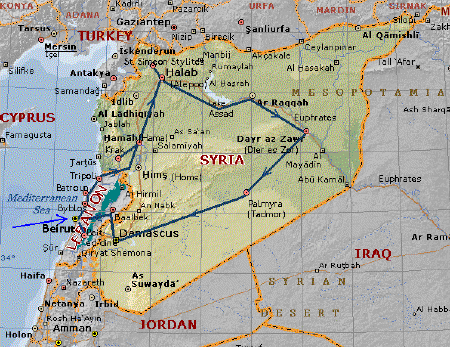 Lebanon and Syria, our itinerary
Lebanon and Syria, our itinerary
We didn't surface very early the next day, and missed breakfast and the room being cleaned! Our hotel was located on a little side road off Rue Hamra, now one of the main shopping streets in Lebanon (after the old centre had been more or less destroyed during the civil war). We spent a few hours just strolling around, getting a feel for the place, getting some cash from a machine (the Lebanese Lira is helpfully more or less the same in value as the old Italian Lira, so we could work prices out very easily) and just getting to grips with a new place. Beirut in general is a very busy mixture of a bit of old and a lot of super-modern, a bit of east and a lot of pseudo-west, a bit of tradition and a lot of attempts at super-chic. While there are a few traditional Muslim women around with their heads covered, most girls and women are dressed in a very western style, and the young are very ready to litter their Arabic with English words. Upper social classes only seem to speak English or French, and to pay in dollars, of course!
We looked in a few shops, had a Starbuck's coffee - the Lebanese are so very pro-West that their idea of a special treat is going to American fast food chains and shops - and then set off to walk a bit further. We walked down to the sea, soon finding the famous Corniche, the promenade and boulevard that circles the entire headland of the city. The coastline is mainly rocky, but there were a few bathers, and we drank up the views of the bay and the very densely packed city of Beirut … as well as a few bottles of water as it was quite warm and humid (though no worse than Milan).
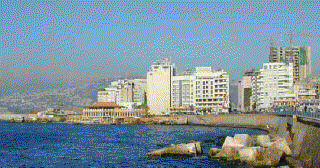 Beirut, Corniche
Beirut, Corniche
We walked back up into the town and stopped for a quick dinner (a salad in "Blimpy", an American fast-food chain), then popped into the hotel before venturing out again. We took a service (shared) taxi to the downtown area of the city, the area that had been almost totally destroyed during the civil war, but is now being rebuilt. The concert by Shaggy and his band was being held in Martyr's Square, as we'd suspected, and we went along, just to have a look. The show was well underway, and when we saw the cost (LL 40,000 or €20) we didn't think we'd bother. The drummer, however, said we should just mention his name, and so we thought we'd try to gate-crash. We were sent to the VIP entrance, and without the slightest problem, we mentioned his name just walked in! It was packed and everyone was standing, so we didn't get particularly good views. The music - a not-too-heavy pop-reggae - was worth listening to, and so we enjoyed the last hour of the show.
After the concert we wandered around the part of the central (downtown) district that has been rebuilt. A good number of stone French-mandate period buildings (early 20th century) have been restored and the area is now a fashionable (and quite expensive) place for open air restaurants, cafés and posh boutiques. There was an open-air exhibition of before-and-after the restoration process which was fascinating, showing how buildings that had been no more than shells after the war were now in pristine form. Unfortunately though, where old buildings have been totally destroyed, their place is being taken by ugly modern office blocks, and a lot more redevelopment in the same style is likely to take place. We sat at a pavement café and watched the world go by, then returned by service taxi to the hotel.
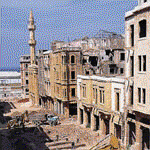
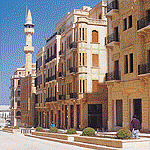 Beirut Central (Downtown) District, before and after
Beirut Central (Downtown) District, before and after
Beirut is a lively, busy, modern city, though with not a lot for the tourist to do. But it is also an excellent base for visiting places nearby. In fact the whole of Lebanon can be visited with day trips from the capital, the whole country being just of 200 km long, north to south. We decided to use the next day (Saturday) to make a day trip to a little town in the hills called Beit-ed-dine. Taking a local bus - the hour's drive costing us just LL 500 (€ 0.25) - we arrived in the sleepy little town a bit before lunch and had some difficulty finding somewhere for lunch. But eventually we found a restaurant with a pleasant terrace and we ordered our first Middle-Eastern style meal. We didn't realise that for the Lebanese, when you order a salad you get a tray containing a head of lettuce, a few tomatoes, cucumbers, radishes and so on, and that you prepare it yourself! But we enjoyed the other bits and pieces, especially the mouttabal (an aubergine dip).
In the afternoon we visited the splendid Ottoman palace at Beit-ed-dine. Built by a local Emir, it is now the president's summer residence, and one area was closed off to visitors as he was there. Also the massive main courtyard was rather spoilt by a temporary theatre structure used for the summer festival held there, and by a strange coincidence the La Scala ballet company was performing that night. The palace is huge. A small first section is dedicated to Jumblatt, the Lebanese leader who did a lot to preserve the palace, and the stables area is dedicated to an exhibition of artefacts and costumes.
A beautiful double staircase leads up to a corridor that then takes you into the palace proper, built around a series of courtyards. The first main courtyard is a stunningly-beautiful marble arabesque expanse with fountains in the middle and various buildings, apartments and rooms around the sides. We looked in many of the rooms, mostly plushly furnished with divans, highly-decorated panelling, stained-glass windows, and even internal fountains to give a soft background noise to mask people's private conversations. The beautiful ceilings and stained-glass windows added to the wonderful overall effect.
We also looked around the old steam-baths and the underground vaults which contain a magnificent collection Greek and Roman mosaics spilling out into the gardens from which there were wonderful views over the valleys. We were a bit reluctant to leave! Later, back in Beirut, we found a friendly restaurant near our hotel called the "So Far" restaurant, where we had fish and chips, Lebanese style!
The next day (Sunday) was our last day in Beirut and so we made sure to see the Monument to Peace erected to mark the end of the civil war 12 years earlier. When the taxi driver eventually found it for us, we spent a few minutes walking around a taking pictures of this new, strange, modern construction, a massive towering block of concrete encapsulating tanks, armed vehicles and other military paraphernalia, almost as if to symbolise the repression of violent combat.
Then we went on to look around the air-conditioned National Museum during the midday heat. The National Museum had been on the dividing line between east and west Beirut during the civil war and had been more or less reduced to a heap of rubble, but it has now been totally restored, and miraculously most of its treasures have survived, some of the large sculptures having been encased in concrete during the fighting due to the foresight of the curator (a short documentary gave a fascinating insight to the destruction and rebuilding). And the pieces on display were truly magnificent. The nation's very best sculptures, mosaics, statues, figures, jewellery, coins, bottles and so on, ranging from pre-history to Ottoman times, are beautifully presented and displayed. We spent almost three hours there, much more than we expected, and were very ready for a bit of lunch afterwards.
We then left our hotel, and took a coach up the coast to a small town called Batroun. The coach dropped us off on the motorway, and we had to run across the motorway with our bags to a waiting taxi parked on the emergency lane on the other side. In just a few minutes we were installed in our room in the San Stephano Beach Resort with good views from our balcony over the pool and to the sea and beach.
We spent three days at Batroun, a couple just resting, relaxing, sunbathing and swimming. It was strange to be the only Europeans in the holiday complex, but everyone was very courteous. As we were in Lebanon (cum-USA), the resort had its own Dunkin Donuts café where we went a couple of times for a snack, but we also found a couple of Lebanese restaurants in the nearby town where we ate well. We returned to one in particular, called "Maracina" where we had delicious seafood and the attention of a very kind waiter who kept plying us with free-of charge extras. The old part of the little town and port of Batroun is quite picturesque, with the fine Maronite church of Saint Stephan.
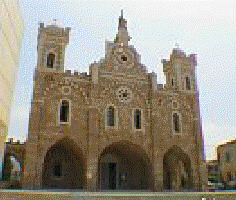 Batroun, Church of Saint Stephan
Batroun, Church of Saint Stephan
We made an excursion on the Tuesday morning to nearby Byblos (modern-day Jbail). The small port had been particularly important from the third century BC to the early centuries AD, exporting timber from Lebanon, and importing and trading in gold, alabaster, papyrus and cereals. As most of the timber and papyrus trade passed through Byblos, the city gave its name to paper in book form, hence our word for the Bible. Down at the port, we peeked in on the famous restaurant of "Pepe the Pirate", an elderly Mexican-Lebanese who has welcomed the rich and famous to his restaurant over the years (from Sophia Loren, to J.F. Kennedy, from Sean Connery to David Niven, all pictured with the owner in walls full of photos) and who has built up a small private collection of pieces and treasures he found mainly during his dives.
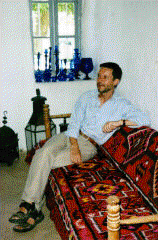
The highlight of Byblos, however, is the archaeological site of the original city, where successive layers of civilisation are piled on top of each other: Egyptians, Phoenician, Greeks, Romans, Crusaders, Mamelukes and Ottomans being just the principal peoples who played a part in the town's history. The vast archaeological site has a small Roman amphitheatre, a Phoenician-Egyptian obelisk temple, a section of Roman road lined with columns, and an imposing Crusader castle, to name just a few of the structures. A fig tree at one point of our tour round the ruins provided a bit of shade and stolen fruit! The town's disappointingly over-restored souk (covered market) now only seems to have tourist shops, but the falafel sandwich we had for lunch in the unattractive new town was probably the best we ever tasted.
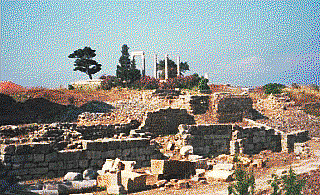 Byblos
Byblos
We left Batroun on Thursday (31st July), a week after arriving in Lebanon, leaving fairly early in the morning for the long day we knew we had ahead of us. Back on the motorway to pick up a bus going north, we soon arrived in the northern Lebanese town of Tripoli (Trablous for the Lebanese). We left our bags at the ticket office where we would be leaving in the afternoon by coach for Syria, and headed off to explore the town. Tripoli is more conservative (and more Muslim) than the Lebanon we'd seen up until then, a bit of a foresight of Syria in many ways. We soon dived into the bustling souks, and concentrated on a couple of the specialities of Tripoli, soap and gold. The old Kahn al-Saboun, the soap-trading court, is now mainly used by one family who trade in special, natural soaps. They have more than 100 different kinds, containing everything from poppy seeds to rose petals. We spent quite a while looking at the tiny gold shops, where prices were very attractive and Carla eventually succumbed to a very fine gold necklace. After a sandwich, we quickly explored the city's Crusader castle, which affords good views of the city, the sea and the green domes of the Mosque, and which provides some interesting insights into life in mediaeval times in the maze of buildings inside the incredibly thick walls.
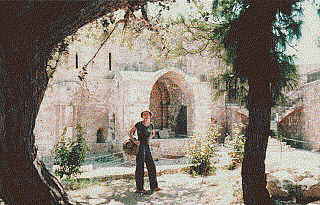 Tripoli, Citadel
Tripoli, Citadel
Back to the coach office, and we left for Syria at 3:30. The onboard assistants were very helpful in getting us through all the red tape at the border, and three hours later we were dropped off in the city of Hama, just two minutes walk from the hotel we were planning to stay at. After the rather pricey, but very comfortable rooms in Beirut and Batroun, the rather basic, but clean room at Hama was a bit of a comedown, but it did only cost S£ 650 (€ 12) per night for a double room with en-suite bathroom. The owners of the Cairo Hotel were very helpful and kind at first, though they became less helpful as time went on as they realised we were not interested in any of the special (and relatively expensive) tours they were only too willing to arrange for us. We had a good meal in a restaurant overlooking the river Orontes which flows through the city of Hama. Syrian food differs very little from Lebanese food. In most places we went we had a variety of starters and forewent the main (meat) course (as the locals also do very often). And the starters ("mezze") are a delicious range of salads, including tabbouleh (parsley, tomatoes and bulgur wheat), fattouch (mixed salad with fried squares of bread), and dips including mouttabal (aubergine dip), hoummos (chick-pea and tahini dip), fuul (creamed broad-bean dip), shanklish (soft goat's cheese and tomato) yoghurt dips, stuffed vine leaves, and much more besides. You eat them by tearing off small pieces of flat Arab bread and using the bread more or less as your cutlery (though forks are usually provided as well).
As the next day, Friday (1st August), was closing day - it being prayer day for Muslims - we decided not to remain in the rather empty city, but to head out for what is described in the guidebooks as the finest Crusader castle of all, Krak des Chevaliers. After breakfasting on some fresh fruit juices (a litre of mixed apple, orange, banana, carrot and strawberry juice is a very filling breakfast for around S£30 or € 0.60), we had a longish journey of over 1½ hours and a change of minibuses to get to Krak. The last part of the journey was quite a twisty ride through predominantly Christian hill towns (Syria has around 10-15% of Christians) up to the castle itself. Already in the distance we could see how imposing it was, and what a wonderfully commanding site it occupied. We visited it reasonably quickly, taking around three hours! The castle is an enormous place, a castle within a castle, a truly impregnable stronghold. And despite the fact that it has been abandoned for centuries, it is almost all intact.
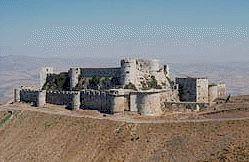
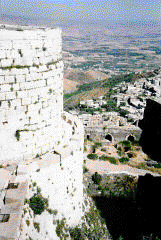 Krak des Chevaliers
Krak des Chevaliers
Inside the massive outer walls, a long, shallow covered ramp leads up to the inner keep, though not without making some hair-pin bends at points to slow down any invaders (who would also have been attacked from all sides and from above during their entry through the ramp). Between the outer walls and the main stronghold, there is a vast moat area, with steam baths, enormous vaulted grain stores, numerous lookout and defence towers. A tunnel - with all kinds of defensive devices - then leads into the main castle. Inside the main stronghold and built around a central courtyard are the knight's hall (with beautiful Gothic tracery windows), a refectory, a chapel, barracks and the tall main keep. The views from the top of the keep were breathtaking, looking far into the distance on all sides.
Exhausted by our tour, we refreshed on some watermelon, then began our journey back. We had difficulty finding a bus to take us back, but with the help of a German girl and a Spanish girl studying Arabic in Damascus - out on a day trip to the castle - we eventually found transport and got back to Hama by 7 o'clock.
We spent most of Saturday getting to know Hama better - about time, too, as we'd already been staying there two nights! Hama is Syria's fourth largest city, but not a particularly large place. A local fundamentalist uprising had been brutally quashed in 1982, and in doing so most of the old souk had been destroyed. So our visit to the souk was a bit of a disappointment, but there were other highlights. The Ottoman governor's Al Azem palace is very attractive, built around a downstairs and an upstairs courtyard, it was interesting to see the various rooms, especially the governor's lavishly-decorated reception hall. The new Hama Archaeological Museum boasts some fine pieces mainly from the city's citadel (of which nothing really survives today), particularly an enormous basalt lion and some excellent mosaics.
But Hama's main claim to fame is its collection of "norias". Dating back to Roman times, the norias are huge waterwheels that raise water from the low-lying river and draw it up to tall aqueducts so that it can be carried to the nearby farmland for irrigation. Though modern methods have largely replaced the wheels, a dozen or so of them are still in action here and there in the city. Up to twenty metres in diameter, they whine and creak as they turn, adding a unique sound as well as a visual dimension to the city.
We also did a bit of people-watching during our time in Hama, getting to know the Syrians better. Most men dress in western-style clothes, though quite a few wear loose, flowing robes and sport headwear that is similar to the Palestinian checked cloth, though red-and-white, rather than black-and-white, protecting the head from the strong sunlight. Just about all of the Muslim women, however, dress in traditional fashion, covering up most of their body. The most "modern" wear trouser suits and headscarves, the most traditional (or rather those with the most "traditional" husbands) wear black from head to foot, over trousers just in case a glimpse of leg might be given while walking, often with the face completely covered or with just the eyes peeking out. As at times these "black bulldozers" as we began calling them hardly seemed to be able to see where they were going, we soon realised it was a good idea to keep out of their way if we didn't want to be knocked over (not least because most of them were quite hefty women). On the other hand, the minority Christian population dress more or less as we do, though they women don't wear any clothes that are very "revealing". In Damascus a few of the younger Muslim women also dress in a more western style, a sign that times are changing. Whatever, we found everywhere that people were generally helpful and considerate, rarely pressing, rarely ready to take us for a ride. We felt extremely safe in the country - in fact petty crime hardly exists - and apart from just a few exceptions, we liked the people very much.
The next day was time to move on again. This time for Aleppo ("Haleb" in Arabic). We booked in at the Baron's Hotel in Aleppo, a very different kind of accommodation from both Lebanon and Hama. Baron's Hotel oozes with faded colonial grandeur. We had been shown a variety of rooms by the helpful staff, disregarding the suites as we felt we didn't really need so much space (or hefty a bill at the end of our stay). We also refused the spacious double room where Agatha Christie had stayed with her husband, as - despite its antique furniture and famous connection - the beds were decidedly old and very hollow in the middle (they may well have been the original mattresses used by Agatha Christie and her husband!). Instead we chose a spacious room with much firmer beds and almost as much charm, even if the furniture wasn't antique. The hotel has a long history of famous guests, from Roosevelt to Churchill, from Agatha Christie to Lawrence of Arabia (who stayed there on a number of occasions and once left without paying his bill, which is now framed and on display in the bar). Built in 1911 by an Armenian family, the hotel has long wide corridors which look like a mix between a French hotel, a Victorian English school and an oriental palace. Little seems to have changed in the ninety-odd years it's been around, including some of the elderly staff!
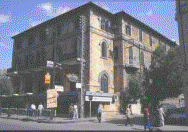 Aleppo, Baron Hotel
Aleppo, Baron Hotel
We had a drink on the hotel terrace, then in the late afternoon set out to explore the northerly part of the city, the large Christian quarter of Jdaide with its Armenian cathedral and Maronite cathedral. The area is full of well-preserved old buildings and narrow cobbled streets, a lot of fun to explore. We found a wonderful old 18th century merchant's house, "Sissi House", which is now a restaurant and had our dinner on a little terrace overlooking the central courtyard where, as we were finishing our meal, a party began for a baptism.
The next day we began to explore the old centre of Aleppo. We first went to the Citadel, a massive stronghold on a steeply-sided hill surrounded by a moat. Used for defensive purposes by various peoples, including the Greeks, Romans, Crusaders and Byzantines, the Citadel is approached via a steep entrance bridge leading up to a monumental gateway. Like the crusader castle of Krak des Chevaliers, it has an entrance ramp inside the walls with tight bends, leading into the vast inside area. Today the Citadel contains an amphitheatre, remains of baths, two mosques (one being the Abraham Mosque on the spot where Abraham milked his cow - Haleb, the Arabic name for Aleppo, in fact means "milk"), barracks, various other housing and storage buildings, as well as the Ayyubid palace and the magnificent throne room, which still has its decorative panelling.
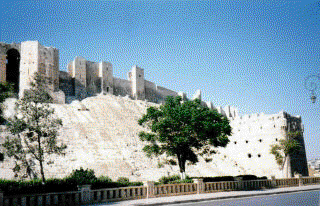
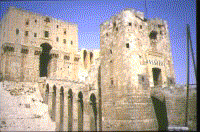 Aleppo, Citadel
Aleppo, Citadel
After our visit to the Citadel and lunch at a pavement café, we dived into the souks. Aleppo's souks are perhaps the best in the Middle East, a maze of 12 km of covered lanes with tiny little shops trading in an incredible array of goods. We visited the Khan-as-Sabun (Aleppo's former centre of commerce for soap) and also spent quite a while with a fellow who trades in carpets, and at his shop we succumbed to his patter. Carla bought a large brown kilim, and I bought a smallish brown-and-blue handwoven Afchan carpet - after a long period of bargaining, we felt the prices were pretty good. Carla also bought some jewellery and some Bedouin scarves. After another thirst-quenching drink, Carla went off for an hour in the hammam (the steam baths) and I went to look at a nearby mosque (that was closed, but still very interesting from outside).
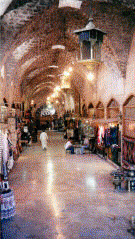 Aleppo, souk
Aleppo, souk
Unfortunately the main mosque of Aleppo is being restored and was completely closed while we were there. We walked back through other sections of the souks, stopping off to look at some of the wonderful fabrics, the terribly gaudy and pretentious costume jewellery, the metalware section and a cotton factory. Unfortunately the main soap factory was closed when we passed it, but we did get a look at the disused (and now open to the public) mental hospital with its inhumanly small airless cells around unnaturally beautiful courtyards. Back near the hotel, we ate in a large "family restaurant" that was very cheap and cheerful, with loud live music and plenty of "atmosphere". The food was pretty good, and the bill came to just S£110 (€2) for the two of us!
The next morning we went to the Aleppo souk area for a second time, concentrating on soap. Aleppo is world-famous for its soap, of course, making it with pure olive oil and laurel oil. We had a fascinating guided tour of a soap factory, seeing where the oil is "cooked" in late autumn (after the olive oil is produced) until it turns thick, then where it is spread out in trays metres long and left for 12 hours until it is almost hardened and ready to be cut up and marked by light young boys. Lastly we saw where it is stored, piled high in "walls" or "cones" which allow plenty of breathing space between the bars. It is sold after it has matured for at least a year, the best quality soap being seven years old! After a falafel sandwich, we walked back through the souks and returned to our hotel for our afternoon outing.
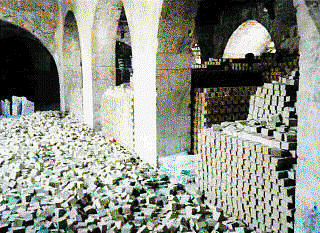 Aleppo, soap factory
Aleppo, soap factory
We'd arranged a special half-day tour to the ruined basilica of Saint Simeon Stylites, in the hills an hour's drive away from Aleppo. And we'd arranged to do the tour in style. We were whisked off by Aleppo's top tour guide, Mr Wahid, in his beautifully-restored 1955 Studebaker Commander (especially in Aleppo, there were lots of old American cars still doing good service, many being used as taxis). We sailed in luxury through olive groves, okra fields, towns and villages until we got to a more rocky and rugged hilly area. The site of the basilica is built around the 17-metre high column (now just reduced to an enormous boulder after pilgrims over the centuries have hacked away at it for souvenir chips) where, on a platform on the top, Simeon lived the life of an ascetic for 42 years. The basilica, or rather the four basilicas forming a cross pattern with the column at their centre, is in an idyllic hilltop location, surrounded by Mediterranean pines, the ruined arches and columns of the basilicas being richly carved. The octagonal baptistery at the other end of a short "via sacra" was also a fine sight.
After the basilica, Mr Wahid drove us to the nearby dead city of Dier Salaam. The whole of the area around Aleppo has numerous "dead cities", ruined cities with few or no inhabitants nowadays, once prosperous cities probably due to their agricultural products, olives in particular, and due to the political stability enjoyed by the area until around the 17th century. We explored various buildings, including a ruined church, and we also looked in on a couple of conical "beehive houses" once the typical kind of building used in the area. A smooth ride back to Aleppo in "Aziza", as Mr Wahid's Studebaker is called by him, and an early dinner so that we could make it an earlyish night before a full day ahead of us the next day.
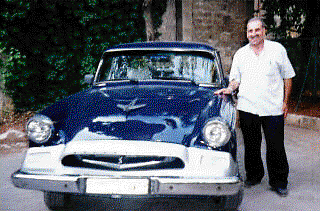 Mr Wahid and Aziza
Mr Wahid and Aziza
Home |
Publications |
Dictionaries |
English Lang. |
Art Insights |
Travel |
Links | ||||||
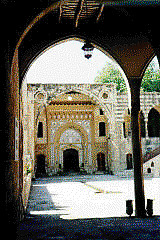
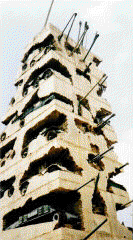
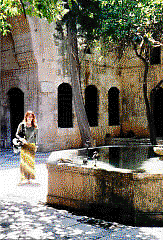
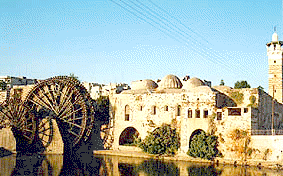
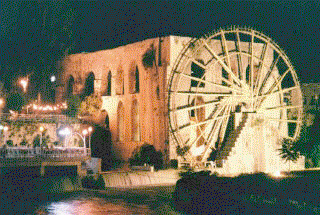
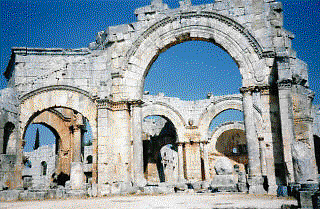
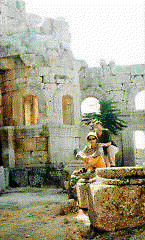 St. Simeon Stylites*
St. Simeon Stylites*